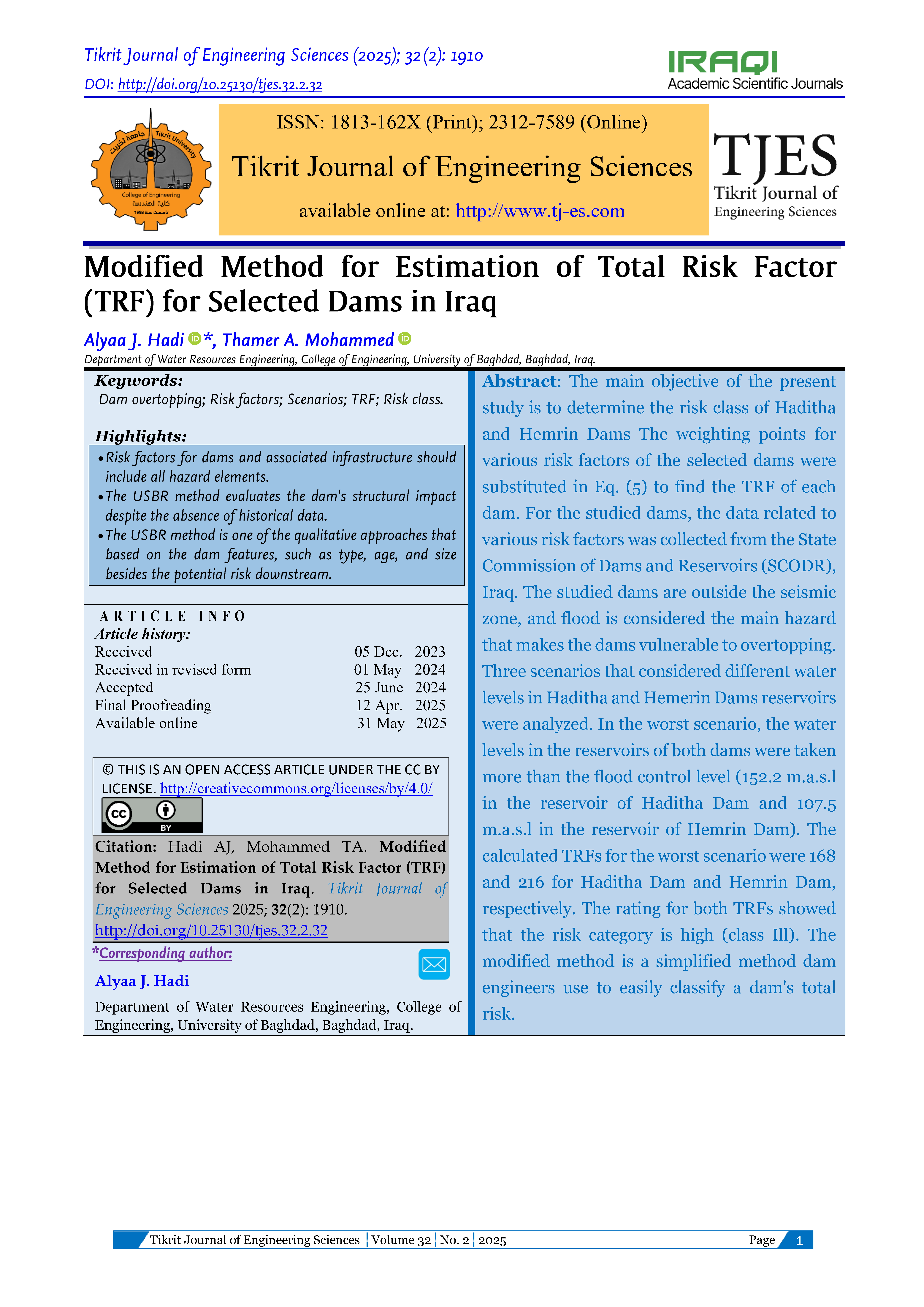Modified Method for Estimation of Total Risk Factor (TRF) for Selected Dams in Iraq
Main Article Content
Abstract
The main objective of the present study is to determine the risk class of Haditha and Hemrin Dams The weighting points for various risk factors of the selected dams were substituted in Eq. (5) to find the TRF of each dam. For the studied dams, the data related to various risk factors was collected from the State Commission of Dams and Reservoirs (SCODR), Iraq. The studied dams are outside the seismic zone, and flood is considered the main hazard that makes the dams vulnerable to overtopping. Three scenarios that considered different water levels in Haditha and Hemerin Dams reservoirs were analyzed. In the worst scenario, the water levels in the reservoirs of both dams were taken more than the flood control level (152.2 m.a.s.l in the reservoir of Haditha Dam and 107.5 m.a.s.l in the reservoir of Hemrin Dam). The calculated TRFs for the worst scenario were 168 and 216 for Haditha Dam and Hemrin Dam, respectively. The rating for both TRFs showed that the risk category is high (class Ill). The modified method is a simplified method dam engineers use to easily classify a dam's total risk.
Metrics
Article Details

This work is licensed under a Creative Commons Attribution 4.0 International License.
THIS IS AN OPEN ACCESS ARTICLE UNDER THE CC BY LICENSE http://creativecommons.org/licenses/by/4.0/
Plaudit
References
Canadian Standards Association. Risk Management: Guidelines for Decision-Makers (CAN/CSA-Q850-97). Ottawa: CSA; 1997:6.
Sadettin T, Hasan T. An Overview on Total Risk Classifications for Dams. 5th Dam Congress 2021.
International Commission on Large Dams. Selecting Seismic Parameters for Large Dams: Guidelines (Revision of ICOLD Bulletin 72). Paris: ICOLD; 1989.
Kuo JT, Hsu YC, Tung YK, Yeh KC, Wu JD. Dam Overtopping Risk Assessment Considering Inspection Program. Stochastic Environmental Research and Risk Assessment 2008; 22(3):303-313. DOI: https://doi.org/10.1007/s00477-007-0116-3
Chen Y, Lin P. The Total Risk Analysis of Large Dams under Flood Hazards. Water 2018; 10(2):140. DOI: https://doi.org/10.3390/w10020140
Tosun H, Seyrek E. Total Risk Analyses for Large Dams in Kizilirmak Basin, Turkey. Natural Hazards and Earth System Sciences 2010; 10:979-987. DOI: https://doi.org/10.5194/nhess-10-979-2010
Al-Geelawee EK, Mohammed AN. Application of Total Quality Management (TQM) Requirements in Risk Management in Construction Projects in Iraq. Journal of Engineering 2016; 22(6):1-15. DOI: https://doi.org/10.31026/j.eng.2016.06.12
Aleqabi GI, Ghalib HAA. Seismic Hazard Assessment of Northern Iraq. Journal of Zankoy Sulaimani - Part A 2016; Special Issue:319-330. DOI: https://doi.org/10.17656/jzs.10488
Adamo N, Al-Ansari N, Laue J, Knutsson S, Sissakian V. Risk Management Concepts in Dam Safety Evaluation: Mosul Dam as a Case Study. Journal of Civil Engineering and Architecture 2017; 11(7):635-648. DOI: https://doi.org/10.17265/1934-7359/2017.07.002
Shadhar AK, Mahmood BB. Risks of Design Stage in Iraqi Construction Projects. Journal of Engineering 2018; 24(3):114-121. DOI: https://doi.org/10.31026/j.eng.2018.03.09
Ghali HM, Azzubaidi RZ. Flood Management of Diyala River. Journal of Engineering 2021; 27(8):32-42. DOI: https://doi.org/10.31026/j.eng.2021.08.03
Joni HH. Identifying Risk Factors Influencing Traffic Accidents for Baghdad Expressways. Journal of Engineering 2022; 40:802-809. DOI: https://doi.org/10.30684/etj.2021.131184.1011
Marwa M, Altaie MR. Use Risk Score Method to Identify the Qualitative Risk Analysis Criteria in the Tendering Phase in Construction Projects. Journal of Engineering 2022; 28(7):31-42. DOI: https://doi.org/10.31026/j.eng.2022.07.03
Mhmood HH, Yilmaz M, Sulaiman SO. Simulation of the Flood Wave Caused by Hypothetical Failure of the Haditha Dam. Journal of Applied Water Engineering and Research 2023; 11(1):66-76. DOI: https://doi.org/10.1080/23249676.2022.2050312
Al-Ani IA, et al. Multi-Criteria Decision-Making to Optimize the Best Runoff Control Measures for the Haditha Dam Reservoir, Iraq. Journal of Environmental Hydrology 2014; 22:1-12.
Ali AM, Odaa MN. Analysis of Mosul and Haditha Dam Flow Data. Journal of Engineering 2014; 20(5):61-75. DOI: https://doi.org/10.31026/j.eng.2014.05.04
Sulaiman SO. Numerical Modeling of Flood Wave Behavior with Meandering Effects (Euphrates River, Haditha-Hit). Journal of Hydraulic Research 2009; 29(7):1227-1240.
Al-Nedawi W, Al-Hadidi M. Finite Element Analysis of Seepage for Hemrin Earth Dam Using Geo-Studio Software. Diyala Journal of Engineering Sciences 2020; 13(3):66-76. DOI: https://doi.org/10.24237/djes.2020.13307
Al-Mohammed TH, Al-Nada NM. Seepage and Slope Stability Analysis for Hemrin Earth Dam in Iraq Using Geo-Studio Software. Solid State Technology 2020; 63(3):2539-2549.
State Commission of Dams and Reservoirs. Technical Report for Haditha Dam and Hemrin Dams. Baghdad: Ministry of Water Resources; 2020.
URS Corporation. Comprehensive Seismic Risk and Vulnerability Study for the State of South Carolina. Columbia: URS; 2001:609.
Iraqi Meteorological Organization and Seismology. Seismic Data Report. Baghdad: IMOS; 2020.
Hameed G, Alameer HA, Fakhry A, Aljabar FA. Emergency Action Plan for Haditha Dam. Baghdad: Ministry of Water Resources; 2016.
Abbas ZI, Altarawne ES. Stability of Earthfill Dams of Materials Containing Soluble Gypsum. Journal of Earth Sciences and Geotechnical Engineering 2020; 10(1):1-13.
Adamo N, Sissakian VK, Al-Ansari N, Knutsson S, Laue J, Ezz-Aldeen M. Comparative Study of Mosul and Haditha Dams, Iraq: Foundation Treatments in the Two Dams. Journal of Earth Sciences and Geotechnical Engineering 2018; 8(2):53-70.
World Bank Group. Good Practice Note on Dam Safety. Washington: World Bank; 2023.





